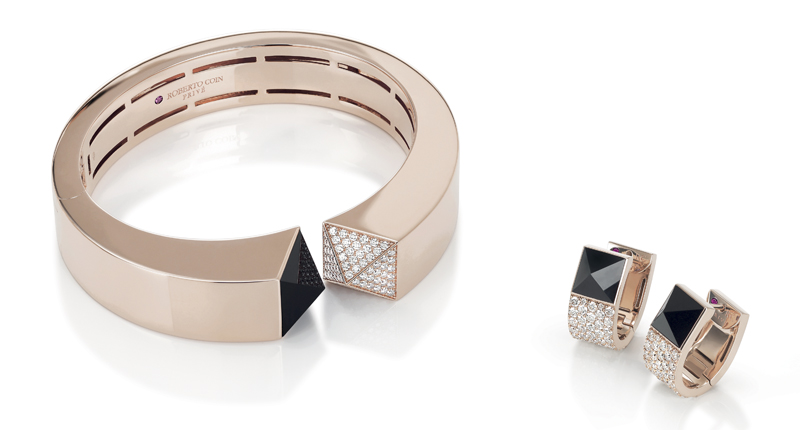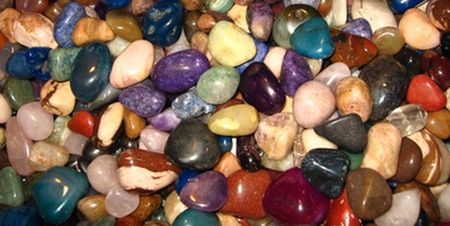Gem Certificates again at issue
In jewelry news now: An accusation of falsified gem certificates – a line of jewelry removed from sale – a lawsuit and a countersuit. What's going on this time?
This time the subject is jade.
 Roberto Coin bracelet and earrings
Roberto Coin bracelet and earrings using black jade
The leadup: Gem supplier Kings Stone had discovered what it describes as "a black jade gemstone with unique qualities" and had this jade examined by China's National Gemstone Testing Center (NGTC). The lab identified the stone as natural black jade and wrote certificates for it using the term "amphibole jade."
Kings Stone began selling this amphibole jade, along with the certificates from NGTC, to Roberto Coin Incorporated, a prestigious jewelry manufacturer. Coin used it in jewelry that it advertised as made with certified amphibole jade.
After a year or two Coin stopped purchasing jade from Kings Stone but continued advertising the gems in its jewelry as amphibole jade certified by NGTC. Kings Stone saw this as fraudulent marketing, arguing that only Kings Stone's jade has been so certified. Kings Stone contacted various retailers of Coin jade jewelry, asking them to verify the NGTC certification, but they could not. Subsequently, Macy's, and perhaps other high-end retailers, removed Coin's jade jewelry from their cases.
Coin filed a complaint against Kings Stone for disseminating false allegations about Coin's jewelry, and King Stone filed a counter suit, accusing Coin of fraudulent marketing of its jade jewelry.
 Jade comes in a variety of colors.
Jade comes in a variety of colors.The lawsuit is still pending, and there is a lot we don't know. The term jade is used for two different minerals, jadeite and nephrite. Both are used in jewelry, and the distinction is important to insurers.
Both jades come in a variety of colors, including black. Jadeite is more durable and more rare, and therefore tends to be more expensive. Nephrite is easier to carve. Neither the news reports nor the lawsuit documents specify which jade is this amphibole jade, though amphiboles are dark-colored minerals typically found in nephrite jade.
We haven't seen any of the NGTC certificates, so we don't know how specifically each gem is described. For this lawsuit, it seems the main importance of the certificate is that it testifies to the uniqueness of this type of jade.
Role of the "Certificate" or lab report
In general, what exactly does a "certificate" certify?
In the jewelry industry, a report from a reputable and trusted independent lab is a valuable document for retailer, consumer, and insurer, because it accurately describes the gem under consideration. The judgment is made by trained gemologists who are independent of the buyer and the seller. To be worthwhile, the lab must have a reputation for accuracy.
Diamonds have been "certified" for some time. Other gems are following suit.
In fact, the word "certified" is such a useful advertising and sales tool that some retailers supply certs that are of dubious value. Retailers may buy certificates in bulk for types of jewelry they sell, where no gemologist has ever looked at the gem being "certified." Some labs are known for giving overly "generous" descriptions of stone qualities in their reports. Some retailers create certificates on their own merchandise, presenting them as verification of their sales pitch. And some labs are completely bogus, with no address or web presence to attest to their gemological credentials or even their existence. Being Certain About That Cert reviews a number of certificate frauds that can victimize retailers, consumers and insurers.
The Gemological Institute of America (GIA) is a highly respected independent grading lab that we have frequently recommended. But even here, an insurer should be cautious. GIA's name on a lab report is so valuable that its certs have been imitated and misused in many ways, as we discuss in GIA & the Magic of Certificates.
FOR AGENTS & UNDERWRITERS
Not everything called jade is jade. Consumers may buy jewelry with stones called Korea jade, Colorado jade, Indian jade, Australian jade, Transvaal jade, Soochow jade, Honan jade, etc. These are not jade at all—they are other (probably green) minerals given exotic sales names.
True jade is either jadeite or nephrite, and these are terms to look for on the appraisal.
|
For jade, it is essential that the appraisal be written by a gemologist experienced with this gem and familiar with the current pricing, treatments and frauds.
Be especially cautious with jewelry bought from sources like online auctions and shopping channels. Terminology may be colorful or general, rather than strict gemological language. Treatments are almost never mentioned in the advertising, and appraisals and lab reports from such sources should not be relied upon. For more discussion, see our issues on Ebay Shopping and TV Shopping.
Jade requires special information for proper valuation. The JISO 78/79 appraisal form prompts the appraiser for all the necessary details about jade. The JISO 78/79 appraisal form is completed by a qualified gemologist (GG, FGA+, or equivalent) who has additional insurance appraisal training. One course offering such additional training is the Certified Insurance Appraiser™ (CIA) course of the Jewelry Insurance Appraisal Institute.
FOR ADJUSTERS
The JISO 78/79 appraisal form prompts the appraiser for information necessary for the proper evaluation of jade. In the absence of JISO 78/79, use JISO 18 to collect needed information from other available documents.
Always have damaged stones examined by a reliable gemologist (who is not the selling jeweler) before settling a claim. For jade, be sure to consult a jeweler/appraiser who regularly deals with jade. The appraiser should also be a qualified gemologist (GG, FGA+, or equivalent) and, preferably, a Certified Insurance Appraiser™.
©2000-2025, JCRS Inland Marine Solutions, Inc. All Rights Reserved. www.jcrs.com

